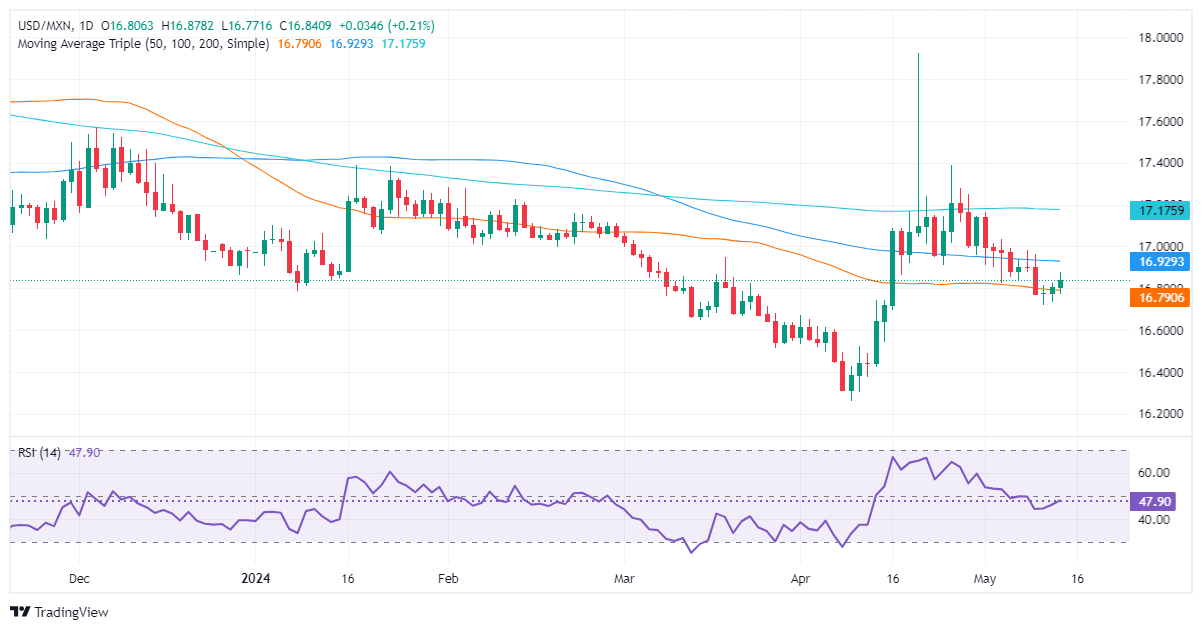- The Mexican Peso falls for the second consecutive day, losing 0.24%.
- Jerome Powell's cautious statements on inflation and the possibility of continued tight policy boost the USD, helped by the high April PPI.
- In contrast to Jerome Powell, Banxico Governor Ceja Rodriguez hints at possible rate cuts, contributing to the Peso's decline ahead of the June 27 meeting.
The Mexican Peso extended its losses against the US Dollar for the second consecutive day, following moderate comments from the President of the Federal Reserve (Fed), Jerome Powell, and moderate comments from the Governor of the Bank of Mexico, Victoria Rodríguez Ceja. The Mexican currency loses 0.56% in the week. The USD/MXN is trading at 16.84 and registers gains of 0.24%.
Fed Chair Jerome Powell said he does not expect a “smooth path on inflation,” adding that it is moving lower and that “my confidence in this is not as high as it was before,” although he expects Gross Domestic Product (GDP) grows 2% or more with a strong labor market.
Powell noted that tight monetary policy “may” take longer than expected to do its job and bring inflation to the Fed's 2% target.
Previously, the US Department of Labor revealed that the Producer Price Index (PPI) for April was higher than expected by some measures, prompting investors to buy the dollar. US Treasury yields rose, while US stocks trended lower before recovering at the time of writing.
On Monday, the governor of the Bank of Mexico (Banxico), Victoria Rodríguez Ceja, declared: “We could evaluate downward adjustments” to the main reference rate. She added that while headline inflation has continued to rise, underlying prices have not. Therefore, depending on the evolution of inflationary prospects, Banxico could consider continuing with its flexibility cycle as soon as the next meeting on June 27. These comments came after the Mexican central bank left the main reference rate unchanged at 11% last Thursday.
Daily summary of market movements: Mexican peso falls after Powell's comments
- Mexico's economic agenda will be absent during the current week. The next economic data to be published will be retail sales, scheduled for May 20, followed by the Gross Domestic Product (GDP), inflation figures and the publication of Banxico minutes on May 23.
- April data shows that Mexico's overall inflation is slowing. However, underlying prices are falling. This has led Banxico to revise its inflation forecasts, with the bank expected to reach its 3% target towards the last quarter of 2025, later than March estimates for the second quarter of 2025. Inflation is expected to underlying will reach 3% in the second quarter of 2025.
- The US Bureau of Labor Statistics (BLS) revealed that the PPI rose 0.5% month-on-month, beating forecasts for a decline to 0.3%, and that the core PPI also expanded at the same pace as the headline data, for above estimates of 0.2%. Both readings were above the -0.1% drop in headline and core inflation in March.
- Following the report, investors trimmed bets that the Fed could cut rates faster than expected, although the odds of a September cut have lately adjusted to 83.6%, up from 79% on Monday.
- The deterioration in consumer confidence, along with the cooling of the labor market, has opened the door for investors to consider rate cuts by the Fed. This is because policymakers at the US central bank recognized that the risks to achieving his dual mandate on employment and inflation “moved toward a better balance over the past year.”
Technical Analysis: The Mexican Peso falls while the USD/MXN exceeds 16.80

The USD/MXN bearish trend remains in play, even though buyers lifted the pair above Friday's close, which could pave the way for a leg higher. In the short term, momentum remains bearish, but the RSI pointing higher suggests that buyers are in control.
At the time of writing, USD/MXN is about to conquer the 100-day SMA at 16.92. Once surpassed, the next supply zone would be the psychological level of 17.00. A break of this latter level would expose the 200-day SMA at 17.17, followed by the January 23 high at 17.38 and the year-to-date high at 17.92.
On the other hand, a bearish continuation could resume if USD/MXN falls below the 50-day SMA at 16.78, opening the door to test the 2023 low at 16.62, followed by the current year-to-date low at 16.25 .
Frequently Asked Questions about the Mexican Peso
What is MXN?
The Mexican Peso is the legal tender of Mexico. The MXN is the most traded currency in Latin America and the third most traded on the American continent. The Mexican Peso is the first currency in the world to use the $ sign, prior to the later use of the Dollar. The Mexican Peso or MXN is divided into 100 cents.
What is Banxico and how does it influence the MXN?
Banxico is the Bank of Mexico, the country's central bank. Created in 1925, it provides the national currency, the MXN, and its priority objective is to preserve its value over time. In addition, the Bank of Mexico manages the country's international reserves, acts as a lender of last resort to the banks and advises the government economically and financially. Banxico uses the tools and techniques of monetary policy to meet its objective.
How does inflation impact the MXN?
When inflation is high, the value of the Mexican Peso (MXN) tends to decrease. This implies an increase in the cost of living for Mexicans that affects their ability to invest and save. At a general level, inflation affects the Mexican economy because Mexico imports a significant amount of final consumption products, such as gas, fuel, food, clothing, etc., and a large amount of production inputs. On the other hand, the higher the inflation and debt, the less attractive the country is for investors.
How does the Dollar influence the Mexican Peso (MXN)?
The exchange rate between the USD and the MXN affects imports and exports between the United States and Mexico, and may affect demand and trade flows. The price of the Dollar against the Mexican Peso is affected by factors such as monetary policy, interest rates, the consumer price index, economic growth and some geopolitical decisions.
How does the Fed's monetary policy affect Mexico?
The exchange rate between the USD and the MXN affects imports and exports between the United States and Mexico, and may affect demand and trade flows. The price of the Dollar against the Mexican Peso is affected by factors such as monetary policy, interest rates, the consumer price index, economic growth and some geopolitical decisions.
Source: Fx Street
I am Joshua Winder, a senior-level journalist and editor at World Stock Market. I specialize in covering news related to the stock market and economic trends. With more than 8 years of experience in this field, I have become an expert in financial reporting.







